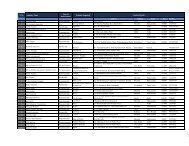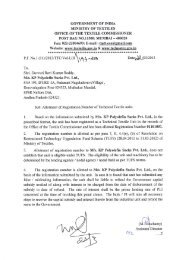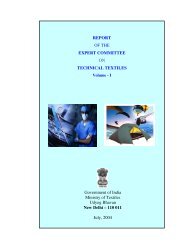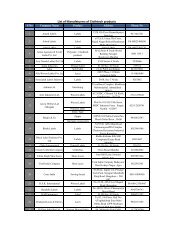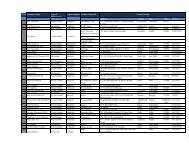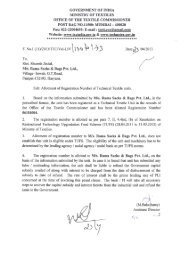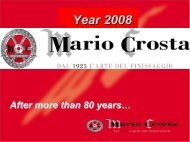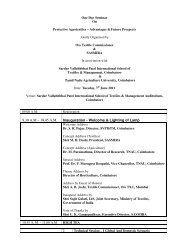STANDARD TEST METHODS FOR MEDICAL TEXTILES - Technotex
STANDARD TEST METHODS FOR MEDICAL TEXTILES - Technotex
STANDARD TEST METHODS FOR MEDICAL TEXTILES - Technotex
Create successful ePaper yourself
Turn your PDF publications into a flip-book with our unique Google optimized e-Paper software.
<strong>STANDARD</strong> <strong>TEST</strong> <strong>METHODS</strong><strong>FOR</strong> <strong>MEDICAL</strong> <strong>TEXTILES</strong>S.KADIRVELSITRASITRA 1
FACE MASKSITRA 2
FACE MASKA surgical face mask is an importantmedical device used to protect bothsurgical patients and operating roompersonnel from the transfer ofmicroorganisms, body fluids andparticulate material.SITRA 3
IMPORTANT <strong>TEST</strong> <strong>METHODS</strong> TO EVALUATEFACE MASK PRODUCT CHARACTERISTICS‣Air permeability‣Bacterial filtration efficiency %‣Splash resistanceSITRA 4
Bacterial filtration efficiency %-ASTM F 2101This test method measures the percent efficiencyat which the face mask filters bacteria passingthrough the mask. The maximum filtrationefficiency that can be determined by this method is99.9%SITRA 5
SPLASH RESISTANCE MMHG-ASTM F1862This test method is used to evaluate theresistance of medical face masks topenetration by the impact of a small volume(2ml) of a high velocity stream of syntheticblood. Medical face mask pass/faildeterminations are based on visual detectionof synthetic blood penetrationSITRA 6
SURGICAL GOWN7
Surgical gowns are worn by the doctorsand nurses in the operating theater toaddress dual function of preventingtransfer of microorganism and bodyfluids from the operating staff to thepatient and also from patient to staffSITRA 8
BASIC REQUIREMENTS NEEDED <strong>FOR</strong>SURGICAL GOWN‣Resist the penetration of liquids andmicroorganisms‣Breathable‣Flexible‣InexpensiveSITRA 9
DIFFERENT TEXTILE STRUCTURES USEDIN SURGICAL GOWN‣Single use type, made up by non-woventechniques‣Reusable category and normallydeveloped through weavingSITRA 10
Major Organizations Have PublishedGuideline For Healthcare Workers• Centers for Disease Control and prevention (CDC)• Association of pre-operative Registered Nurses(AORN)• Occupational Safety and Health Administration(OSHA)• Operating Room Nurses Association of Canada(ORNAC)• Association for the Advancementof MedicalInstrumentation (AAMI)SITRA 11
AAMI CLASSIFICATIONThere are four tests that must be performedin order to evaluate the performance ofsurgical gown.1. Spray Impact Penetration Test2. Hydrostatic Head Test3. Resistance to synthetic blood4. Viral penetration resistanceSITRA 12
AAMI CLASSIFICATION SYSTEM• There are four levels of barrier performance, level 4 being the highestprotection availableLevel Test ResultLeastProtective1AATCC 42Water Impact (WI)< 4.5 g2AATCC 42, WIAATCC 127 Hydro Head (HH)< 1.0 g> 20 cmMostProtective34AATCC 42, WIAATCC 127, HHASTM F1671, GownsASTM F1670, Drapes< 1.0 g> 50 cmPassPass• AAMI - Association for the Advancement of Medical Instrumentation13
SPRAY IMPACT PENETRATION <strong>TEST</strong>:AATCC 42A volume of synthetic blood is allowed tospray against the taut surface of a testspecimen backed by a weighed blotter. Theblotter is then reweighed to determine waterpenetration and the specimen is classifiedaccordingly.14
WATER RESISTANCE: HYDROSTATICPRESSURE <strong>TEST</strong>One surface of the test specimen issubjected to a hydrostatic pressure,increasing at constant rate, until threepoints of leakage on its surface. Thewater may be applied from above orbelow the test specimen.15
Resistance to synthetic blood-ASTM F 1670A specimen is subjected to body fluid stimulant(synthetic blood) for a specified time and pressure.Visual observation is made to determine whenpenetration occurs. Any evidence of synthetic bloodpenetration constitutes failure. Results are reportedas pass or fail16
OTHER <strong>TEST</strong> <strong>METHODS</strong>EVALUATE THE SURGICAL GOWN‣ Water vapour transmission rate‣ Tensile Strength‣ Air Permeability‣ Stiffness‣ Flammability‣ Bursting strength‣ Thermal resistanceSITRA 18
INTERNATIONAL SPECIFICATIONS<strong>FOR</strong> SURGICAL GOWN‣ Specification for surgical gown-ASTM F 2407This specification establishes requirements for theperformance, documentation, and labeling forsurgical gowns used in healthcare facilities‣ European EN 13795 aims to establishrequirements for surgical gown, surgical drape andclean air suits used as medical devices for patients,clinical staff and equipmentSITRA 19
SURGICAL DRAPESITRA20
<strong>TEST</strong> <strong>METHODS</strong>‣ Drape‣ Air permeability‣ Weight per unit area‣ Breaking strength and elongation of textile fabrics‣ Flammability‣ Anti bacterial activity assessment (Qualitative)‣ Antibacterial activity assessment (Quantitative)‣ Thermal resistance‣ Linting testSITRA21
HOSPITAL BED LINENSITRA 22
<strong>TEST</strong> <strong>METHODS</strong> TO EVALUATE THECHARACTERISICS OF BED LINEN‣Weight/square metre‣Tensile strength‣Tear strength‣Antibacterial activity assessment(Qualitative)‣Antibacterial activity assessment(Quantitative)SITRA 23
BABY DIAPERSITRA 24
‣Diaper is used for wrapping the newly bornor young children, who have not developedthe fixed routine for making water or latrine.‣Diapers retain the liquid for about two hoursSITRA 25
‣ Diapers can play an important role incontamination prevention and the reduction ofinfection‣ Disposable diapers are more effective inurine/feces containment than cloth‣ Increased contamination of surfaces in day caresettings has been linked to infectious diarrheaoutbreaksSITRA 26
DIAPER CONSTRUCTION‣Cover stock / top sheet layer (non-wovenmaterial)‣Absorbent core (Cellulose fluff pulp + Superabsorbent polymer)‣Back sheet: Polyethylene film structure or afilm / non-woven compositeSITRA 27
IMPORTANT PROPERTIESREQUIRED <strong>FOR</strong> THE BABY DIAPER‣ Soft‣ High absorbency‣ Protection against leakage‣ Should not re-wet‣ ComfortableSITRA 28
<strong>TEST</strong> <strong>METHODS</strong> TO EVALUATETHE FUNCTION OF BABY DIAPER‣ Speed of Absorption‣ Re-wet‣ Absorbent Capacity‣ Absorbent Retention‣ Fit and ComfortFirst three performances are veryimportantSITRA 29
LIQUID – STRIKE THROUGH TIME(SIMULATED URINE)This test method measures the strikethrough time (i.e.) the time taken for aknown volume simulated urine appliedto thesurface of atest piece ofnon-wovencover stock, which is incontact with an underlying absorbentpad, to pass through non-woven.SITRA 30
DIAPER RE-WETThe purpose of the test is to examinethe ability of diaper cover stock to resistthe transport back onto the skin of aliquid which has already penetrated thecover stock.SITRA 31
INCONTINENCE PRODUCTSITRA 32
INCONTINENCE PRODUCT <strong>TEST</strong>ING‣ Volume of leaked liquid‣ Absorption rate‣ Wicking rate‣ Wettability‣ PermeabilitySITRA 33
SANITARY NAPKINSITRA 34
‣ Absorbency<strong>TEST</strong> <strong>METHODS</strong>The sanitary napkins shall absorb 30ml of coloured water or oxalatedSheep or goat blood or test fluid whenlowed onto the centre of the napkin(at the rate of 15 ml per minute) and itshall not stain through/leak throughat the bottom sides of the sanitarynapkinSITRA 35
<strong>TEST</strong> <strong>METHODS</strong>‣ pH ValueThe sanitary napkin shall be free fromacids and alkali and the pH of theabsorbent material shall be 6 to 8.5‣ DisposabilityA disposable sanitary napkin with thecovering removed, shall be immersed in15 litres of water and stirred. The padshall disintegrate in the water in not morethan 5 minutesSITRA 36
GAUZE BANDAGESITRA 37
Test methods to evaluate the characteristicsof Gauze bandage‣ Yarn count (Tex)‣ Threads/10cm‣ Colouring matter‣ Surface active substances‣ Sulphated ash‣ Ether soluble substances‣ Water soluble substances‣ Loss on drying‣ Foreign matter‣ Viable micro organism prior to sterility (cfu/gram)‣ pH‣ Absorbency(second)SITRA 38
PLASTER OF PARIS BANDAGESITRA 39
<strong>TEST</strong> <strong>METHODS</strong> TO EVALUATE THECHARACTERISTICS OF PLASTER OFPARIS BANDAGE‣ Threads per unit length‣ Weight of the fabric (GSM)‣ % Calcium sulphate‣ Tensile strength, kg/cm2‣ Compressive strength kg/cm2‣ Setting time, minutes‣ AlkalinitySITRA 40
CREPE BANDAGESITRA 41
<strong>TEST</strong> <strong>METHODS</strong> TO EVALUATE THECHARACTERISTICS OF CREPE BANDAGE‣ Yarn count‣ Warp yarn twist‣ Threads/10cm‣ Stretchability‣ Breaking load‣ pHSITRA 42
NON-WOVEN GAUZE BANDAGENon-woven gauze is of mesh structure(similar to woven cloth) made fromviscose rayon, polyester blend fabricwith minimum 65% viscose content.SITRA43
<strong>TEST</strong> <strong>METHODS</strong>‣ Weight (GSM)‣ Length and width‣ Fluorescence‣ Sterility‣ Foreign matter‣ Absorbency (second)SITRA44
SUTURESSITRA 45
Tests should be carried out for sutures‣ Diameter‣ Tensile strength‣ Bending stiffness‣ Surface roughness‣ Knot pull strength‣ Knot securitySITRA 46
CIRCULAR KNITTED BANDAGESSITRA47
THE FOLLOWING <strong>TEST</strong>S SHALL BECONDUCTED <strong>FOR</strong> CIRCULAR KNITTEDBANDAGES‣ Thickness‣ Air permeability‣ Weight per unit area‣ Breaking strength and elongation of textile fabrics‣ Skin irritation‣ Anti bacterial activity assessment (Qualitative)‣ Antibacterial activity assessment (Quantitative)‣ Thermal resistanceSITRA48
COMBINED WOUND DRESSINGSSITRA49
‣ Wound contact layer‣ Middle absorbing layer‣ Base materialSITRA50
THE FOLLOWING <strong>TEST</strong>S SHALL BECONDUCTED <strong>FOR</strong> COMBINED WOUNDDRESSINGS‣ Skin irritation test‣ Air permeability‣ Weight per unit area‣ Breaking strength and elongation of textile fabrics‣ Absorbency‣ Anti bacterial activity assessment (Qualitative)‣ Antibacterial activity assessment (Quantitative)‣ Thermal resistanceSITRA51
Elastic adhesive bandageIt consists of a woven fabric, elastic in warpdirection and coated with the adhesive masscontaining zinc oxide. The adhesive massmay be porous or permeable to air and watervapourSITRA52
Test methods‣Threads per 10cm‣Weight of the fabric (GSM)‣Weight of adhesive mass‣Zinc oxide content in adhesive mass‣Adhesive strength g/2.5cm‣Moisturevapour permeability‣Regain lengthSITRA53
CELLULOSE WADDINGCellulose wadding consists of compressedsheets of felted fibres, consisting almostentirely of cellulose. The fibres are bleachedgood white.SITRA54
<strong>TEST</strong> <strong>METHODS</strong>‣ Weight per unit area (GSM)‣ Sulphated ash‣ Loss on drying‣ Absorbency(second)‣ Chloroform soluble substancesSITRA55
VASCULAR GRAFTSITRA 56
Arteries are the blood vessels, whichcarry oxygenated blood throughout thebody. These arteries sometimes getdamaged and fail to do the workproperly. Artificial grafts are developedto act as blood vessels and they arecalled as vascular grafts.SITRA 57
<strong>TEST</strong> <strong>METHODS</strong> TO EVALUATEVASCULAR GRAFT‣ Biocompatibility‣ Porosity‣ Bursting strength‣ Tensile strength‣ Water permeabilitySITRA 58
IMPLANTABLE <strong>TEST</strong> <strong>METHODS</strong>Most of the implantable products will be testedfor the Biocompatibility test‣Biocompatibility- Reaction of textile with bloodand tissue of the body‣This test & skin irritation test can be conductedat Sree Chitra Tirunal Institute for MedicalSciences and Technology (SCTIMST),TrivandrumTrivandrum. SITRA59
ROLE OF SITRA <strong>TEST</strong>ING SERVICES<strong>FOR</strong> MEDITECH PRODUCT‣Preparation of proposed draft standardsfor different Meditech product‣Facilities for testing and evaluation ofproducts of medical textilesesSITRA60
PROPOSED <strong>STANDARD</strong> <strong>TEST</strong><strong>METHODS</strong> <strong>FOR</strong> MEDITECHPRODUCT DEVELOPED BY SITRASITRA61
‣ Gown‣ Surgical drapes‣ Face mask‣ Bed linen‣ Baby diaper‣ Incontinence products‣ X-ray detectable gauze‣ Gauze bandageSITRA62
‣ Plaster of Paris bandage‣ Elastic adhesive bandage‣ Cellulose wadding‣ Impermeable plastic wound dressings‣ Crepe bandages‣ Sutures‣ Absorbent cottonSITRA63
‣ Non-woven gauze bandage‣ Vapour- permeable waterproof plasticwound dressings‣ Vascular craft‣ Perforated film dressings‣ Knitted viscose primary dressingsSITRA64
FEATURES OF NEW <strong>TEST</strong>INGFACILITIES AVAILABLE IN SITRAMEDITECH LABSITRA65
LISTER AC & WETBACKSITRA66
SITRA 67
Test piece is placed on filter papersSimulated urine is discharged on to a test piecethrough strike plateElectrical conductive liquid starts the timer bymeans of electrodesAfter the liquid has penetrated into the absorbentpad the electrical circuit is interrupted and thetimer is automatically stoppedSITRA68
WETBACKSITRA69
WETBACKAfter test piece has been tested with liquid strike through test15 ml of simulated urine has to be addedThe dead weight is lowered and put on to the test pieceFilter papers are weighed & placed it onto the sampleThe weight once again lowered and put onto the sampleFilter paper reweighedSITRA70
SWEATING GUARDED HOT PLATESITRA71
‣ THERMAL RESISTANCE, RCTTemperature difference between the two faces of amaterial divided by the resultant heat flux per unitarea in the direction of the gradient.‣ WATER-VAPOR RESISTANCE, RETWater-vapor pressure difference between the twofaces of a material divided by the resultantevaporative heat flux per unit area in the directionof the gradientSITRA72
BACTRIAL FILTERATIONEFFICIENCY <strong>TEST</strong>ERSITRA73
‣This instrument measures the percentefficiency at which the face mask filtersbacteria passing through the mask.‣The maximum filtration efficiency (99.9%)can be determined.SITRA74
Bacteria aerosol is passed into the 6 agarplates without specimenThe control samples collected & placed inincubatorBacteria aerosol is passed with specimenTotal the counts from each of the six agarplateBacterial filtration efficiency is calculatedSITRA75
Hydro head testerSITRA76
Specimen is clamped in testing headHydrostatic pressure is applied on bottom layer ofthe specimenObserve the top layer of the specimenStop the test when observe 3 dropRecord the average hydrostatic pressureSITRA77
3 DROP IMAGESITRA78
INSTRON 6021SITRA79
‣ Tensile strength and elongation‣ Peel strength‣ Stress relaxation‣ Creep‣ Cohesive force‣ Knot strengthSITRA80
Centre of Excellence‣ SITRA has been identified as Centre ofExcellence for Medical and HygieneTextiles by The Ministry of Textiles,Government of India.‣ For more detail please visit our websites:www.sitra.org.inwww.sitrameditech.org.inSITRA 81






